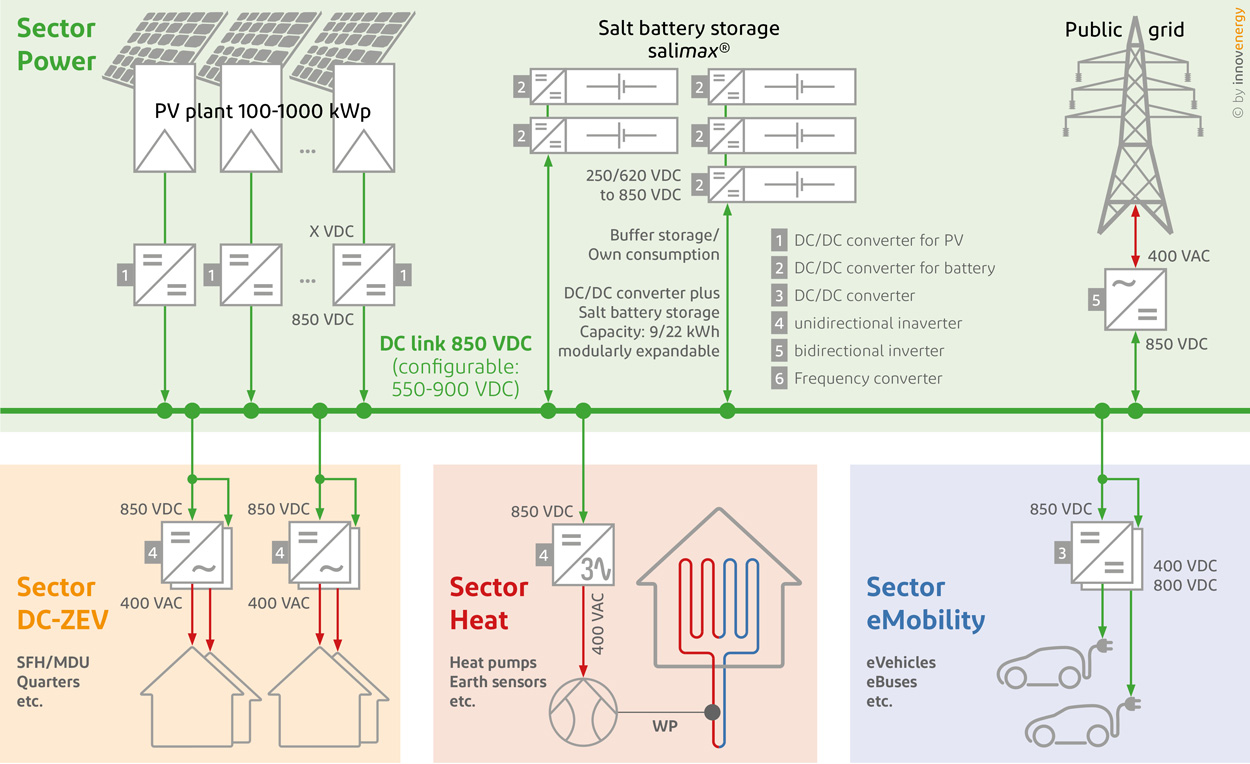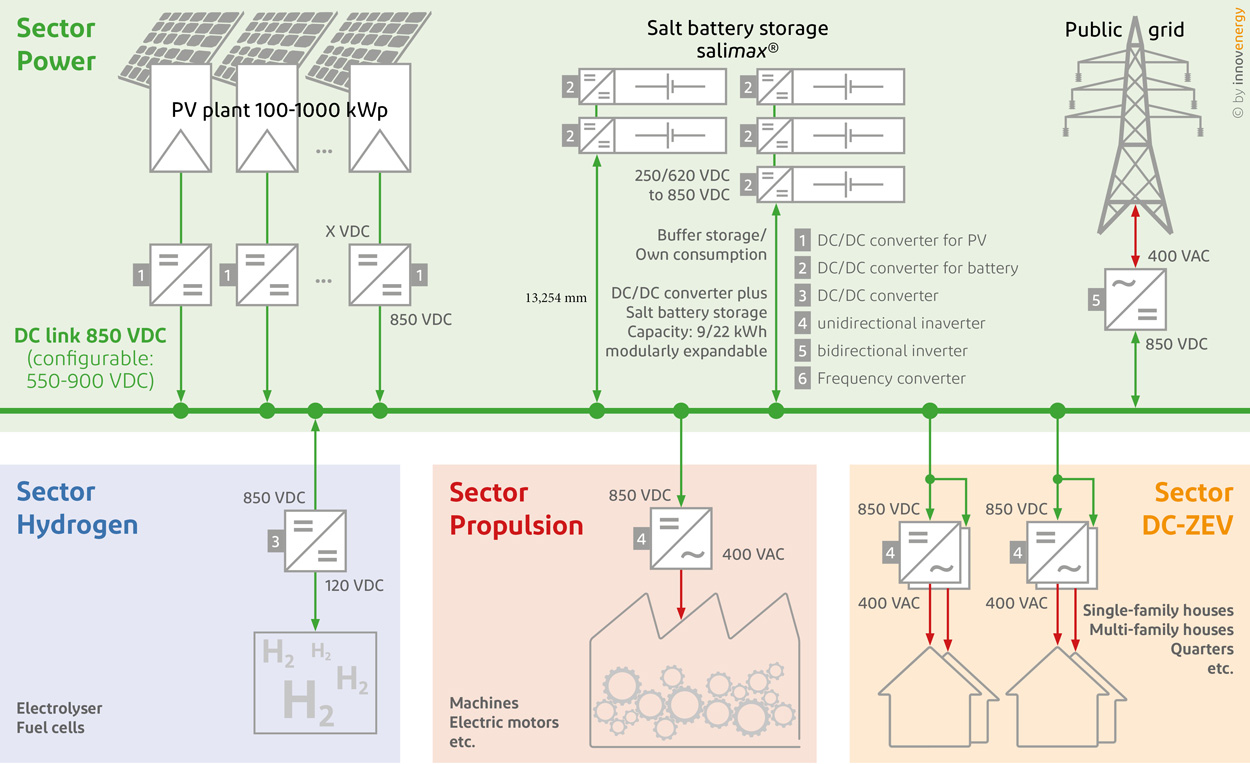
What is a DConnect®
Here you can find out everything about what a DConnect® actually is, which components it is made up of and how a DConnect® is constructed.

Application examples
Discover the many possibilities where a dedicated DC grid makes sense. From supermarkets to ZEV applications, sector couplings up to emergency power solutions e.g. for a data centre.

Range of services
In brief, you will find innovenergy®'s range of services here. You can also contact us right away and write us an eMail:
sales@innov.energy

Project enquiry
You would like to make a written enquiry and tell us about your project in brief. Then the DConnect® enquiry form is the best way to hear from us as quickly as possible.
What is a DConnect®?
The DConnect® is a self-regulated DC microgrid with a simple integration of DC producers and DC consumers with the benefit of higher energy efficiency through the reduction of conversion losses.
The DConnect® consists of a new photovoltaic system, a connection (DC link) between energy producers and consumers as well as various inverters, voltage transformers and frequency converters.
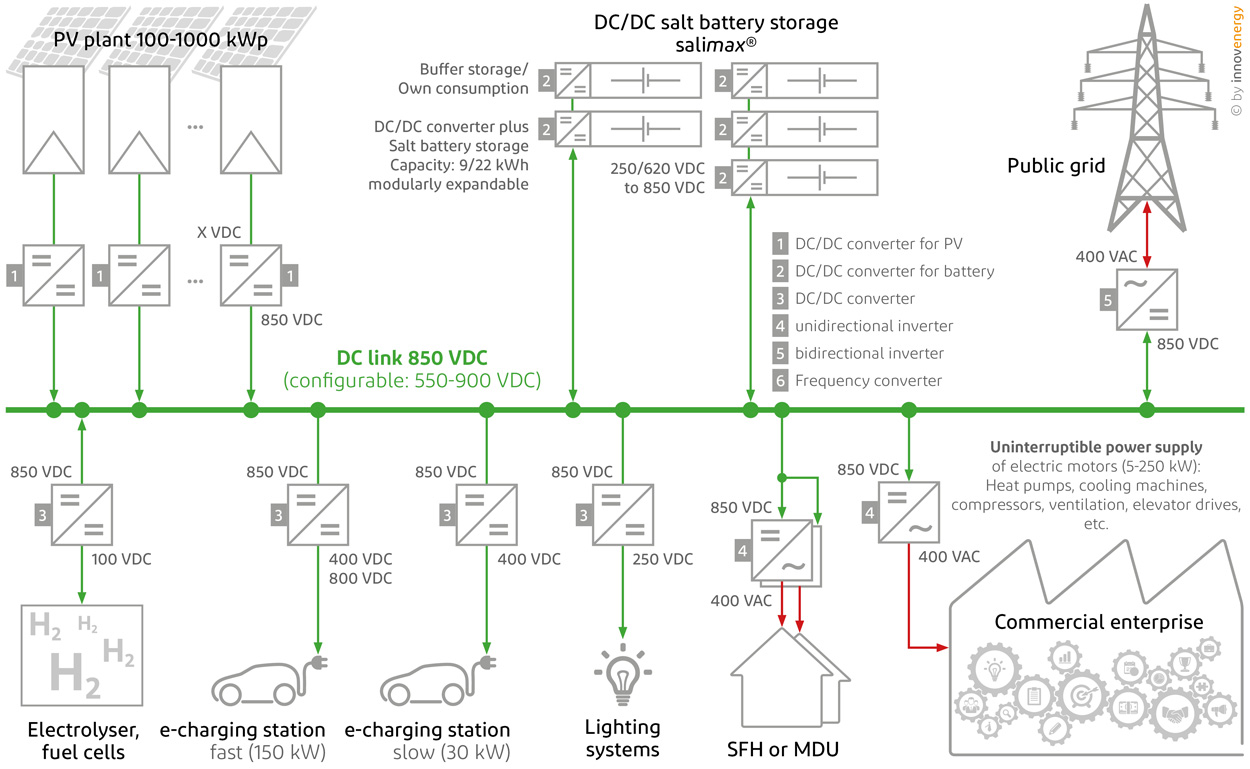
Advantages of a DConnect®
Install AND use maximum PV – avoid expensive AC grid expansion
This is interesting if the PV potential is large, but the AC grid connection is too small and AC grid expansion is very expensive or not possible.
15% more system energy efficiency
AC/DC/AC conversion losses are reduced
Better self-consumption optimisation
Maximum utilisation of PV electricity on the AC side AND on the DC side results in maximum self-consumption
High availability due to islanding capability
- Emergency power supply with zero additional costs.
- A DC grid with DC-coupled battery storage behaves like an uninterruptible power supply.
- The power supply also works in the DConnect® without an AC grid.
Ideal for distributed producers and consumers
Excellent for distributed photovoltaics on different roofs, distributed storage or distributed consumers, which are all easily connected to the DC link.
DC ZEVs possible
Relief of the AC infrastructure while retaining the existing AC connections (AC grid connection remains)
Sector coupling can be realised easily and according to demand
Classification of producers and consumers into sector groups for more efficient management
Modular, future-proof expandability of producers and consumers
DConnect® grows with your needs and requirements
Cost savings with DConnect®
Less copper
- 3 conductors instead of 5
- Higher voltage
- DC uses the whole conductor cross-section (AC only the outer edge = skin effect)
Lower total project costs per kWp and kWh
- DC/DC converter with MPPT: cost-effective and compact
- Halving of PV strings from DC/DC converter to GAK, two DC cables from GAK to inverter
- Only one inverter to the grid
Better returns on electricity sales
- Higher electricity yields due to lower energy losses
- Amortisation of the DConnect® through the costs included in the sales tariff
- Tenants/consumers pay less for truly environmentally sustainable electricity
- Win-win situation for electricity producers and electricity tenants
Modular system DConnect®
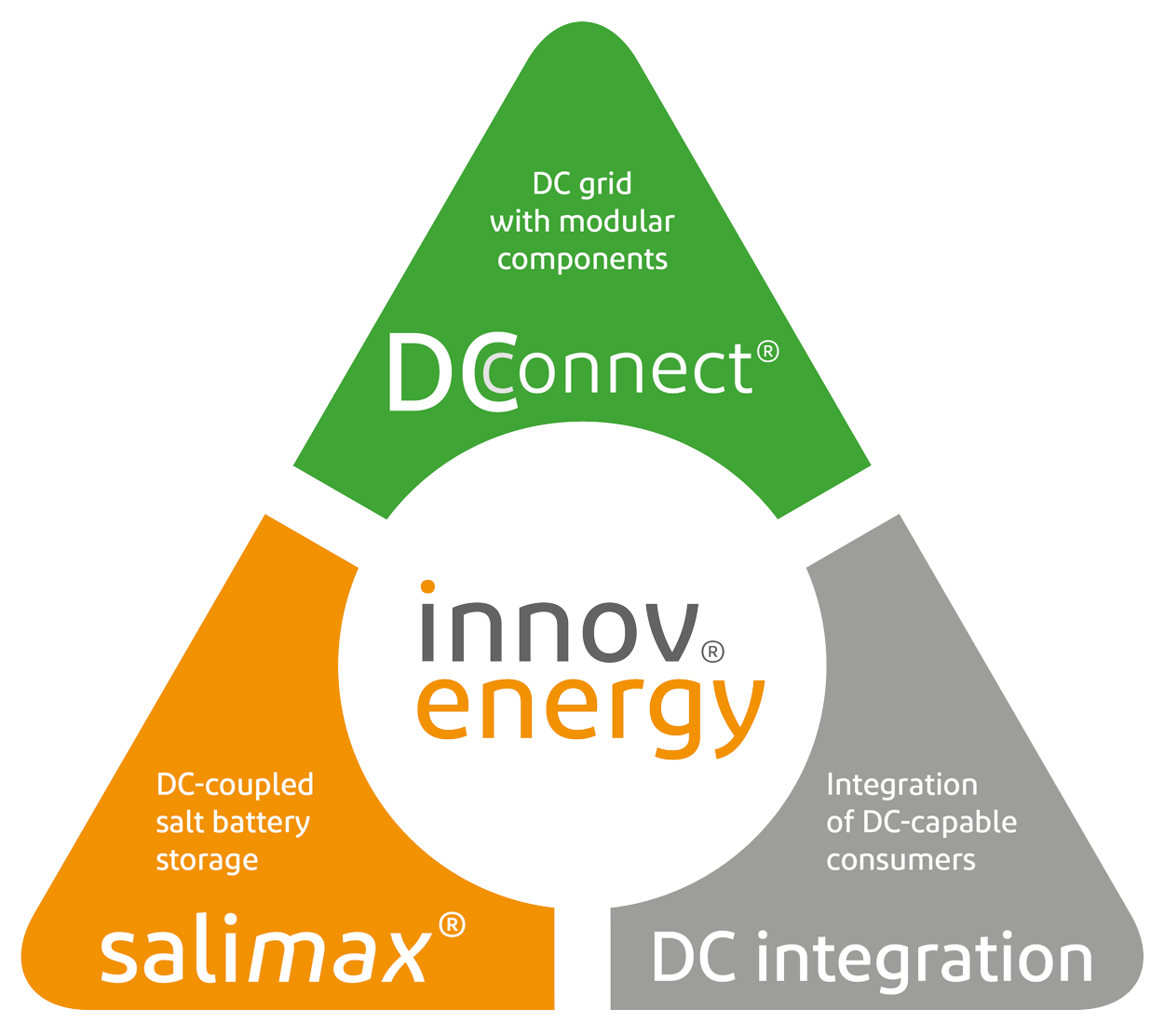
DConnect® | Grid Solutions
DC grid with modular components consisting of a new PV system, DC link and highly efficient voltage transformers and inverters
salimax® | DC storage battery
DC-coupled salt battery storage from 100 kWh storage capacity – expandable up to 1.4 MWh
DC integration
Integration of commercially available DC-capable consumers such as heat pumps, e-charging stations, electrolysers, etc.
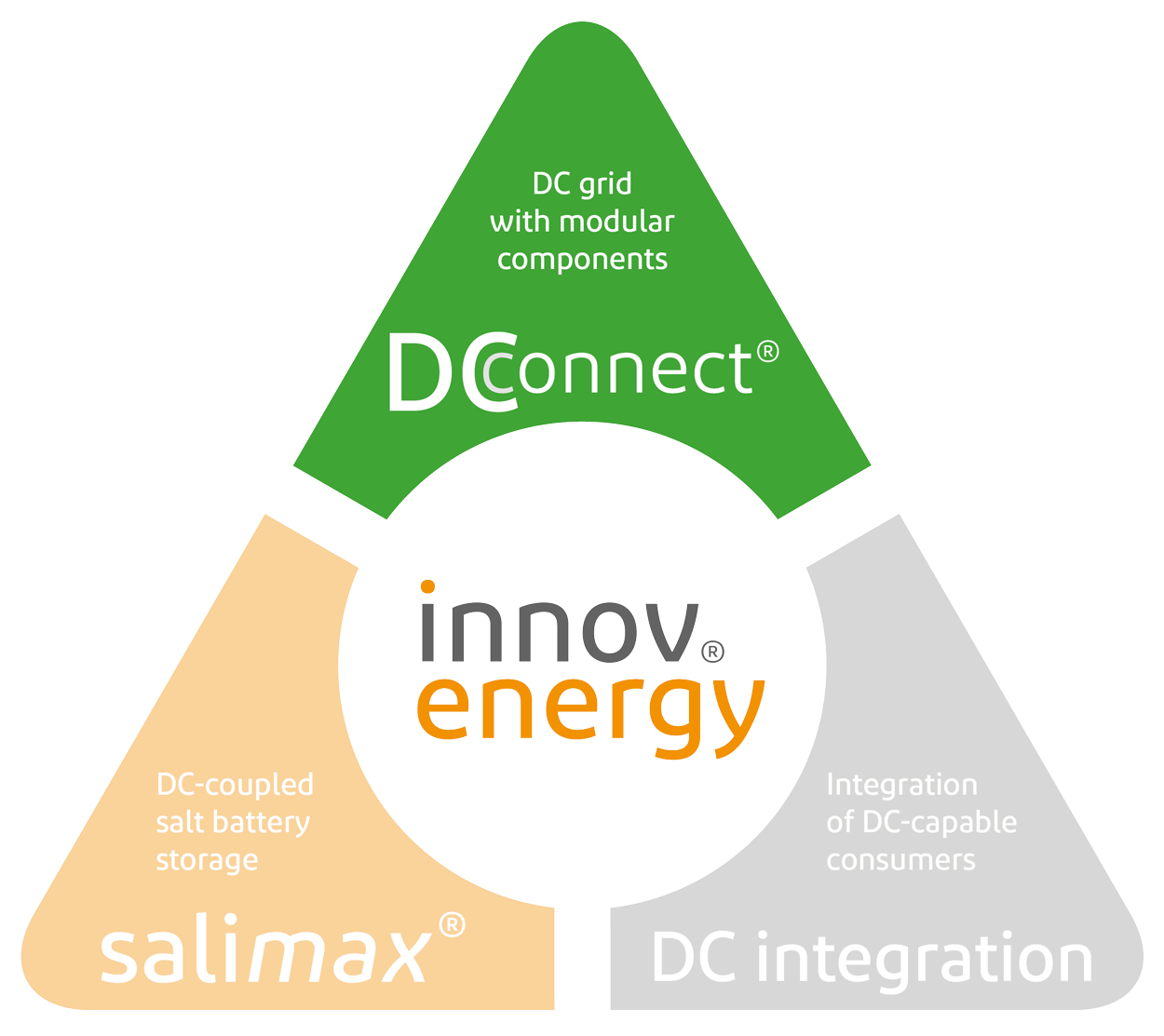
Powerful DC link
Cable link between DC producers and DC consumers (freely customisable) between 550 VDC-900 VDC
New photovoltaic system with MPPT
with an output of 100 kWp to over 1 MWp
Highly efficient DC/DC converters
(η = 98% to 99%) from the photovoltaic system to the DC link
Uni- or bidirectional DC/AC inverters
Connection via inverters to the AC grid for export and import of AC power with the corresponding existing AC connection power
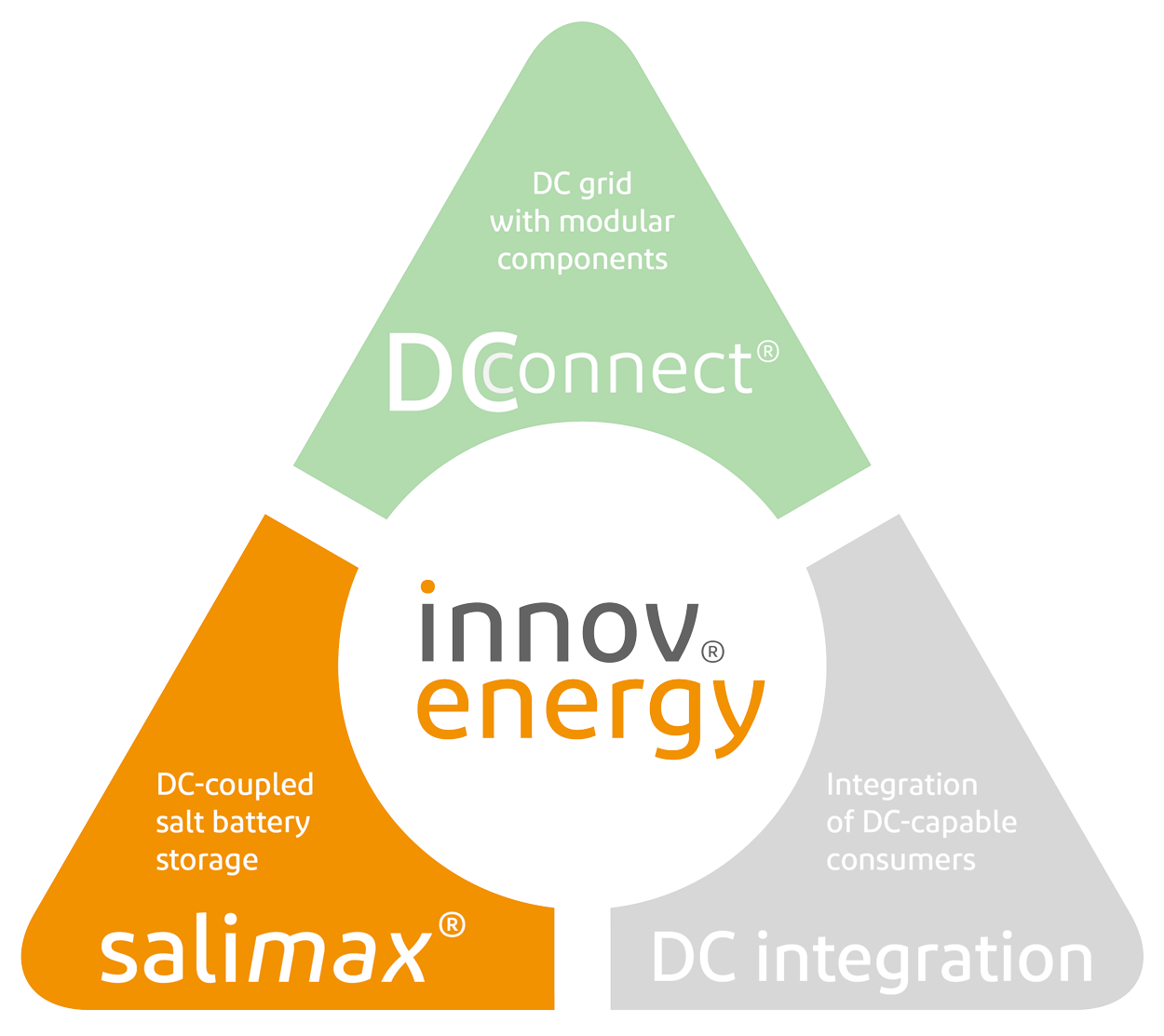
Ecological salt battery storagesalimax®
Salt battery storage with built-in DC/DC converter (on board) for self-consumption optimisation, buffering of energy or for peak shaving
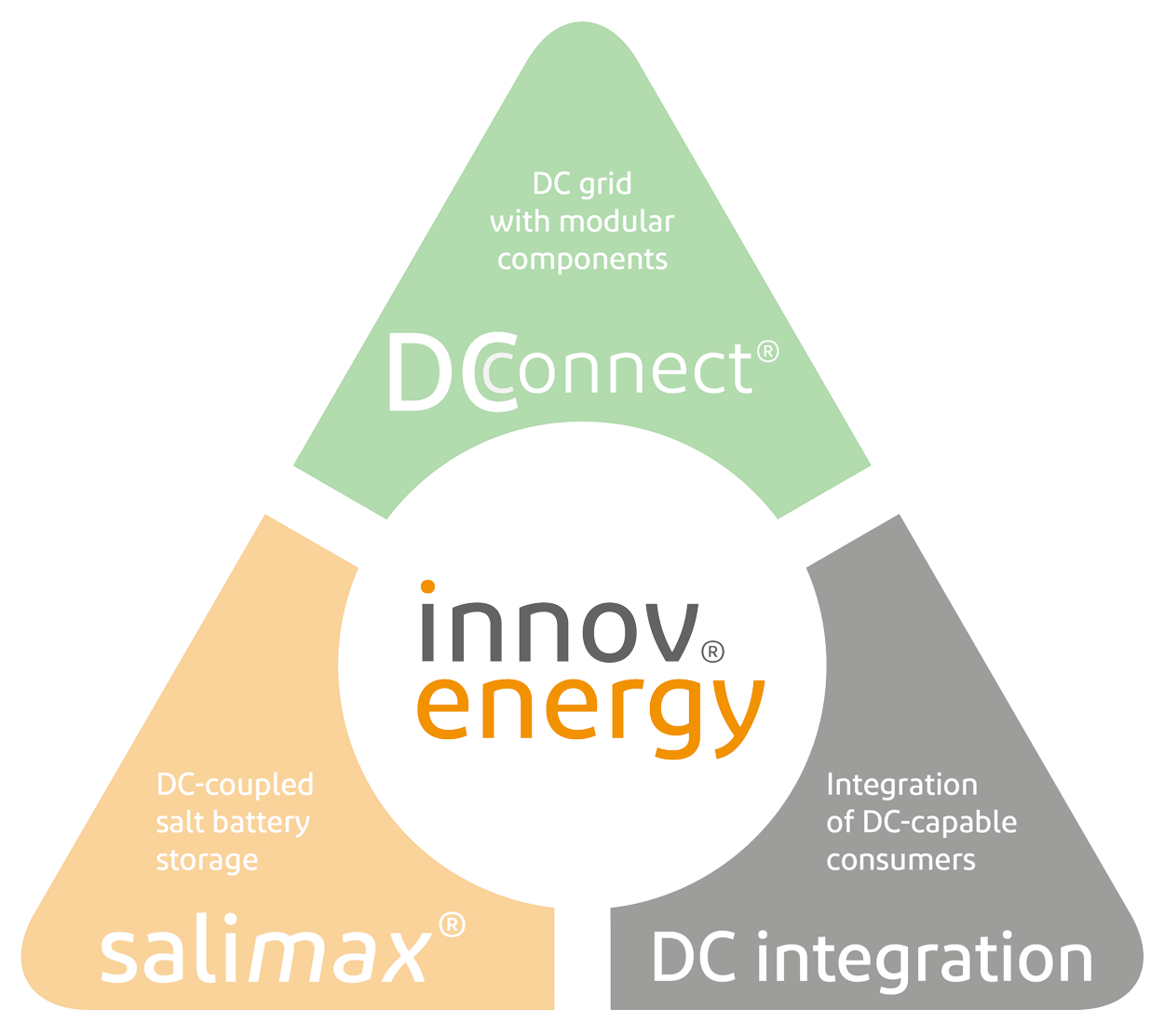
Integration of various DC consumers
- DC/DC (fast) charging stations for e-vehicles
- Electric motors via frequency converters (heat pumps, CNC machines, etc.)
- Lighting systems via DC/DC converters
- H2 via DC/DC converters
- and much more
DC microgrid control
In more complex installations with several DC producers and non-controllable DC consumers (e.g. frequency converters), the inverters are adjusted to the grid or battery storage.
Range of services innovenergy®

Engineering
The engineering includes detailed consultation, conception and planning of the DC grid project as well as the presentation of the feasibilities and implementation.
Get in touch with us right away:
sales@innov.energy

System components
Selection and procurement of the components individually tailored to the needs of the DC grid

Project management
Support in the organisation and implementation of the selected DC grid concept through all project phases
Application examples for DC microgrids
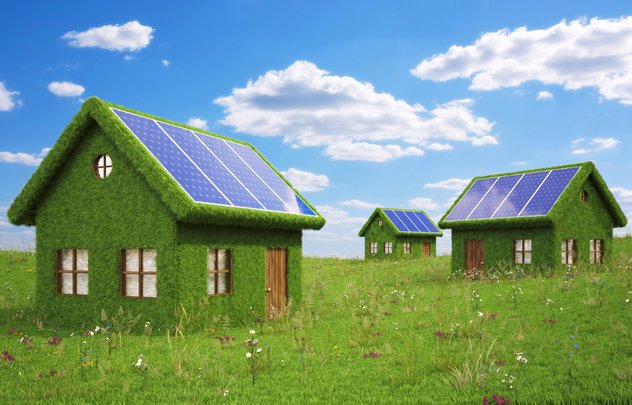
ZEV / Energy Communities
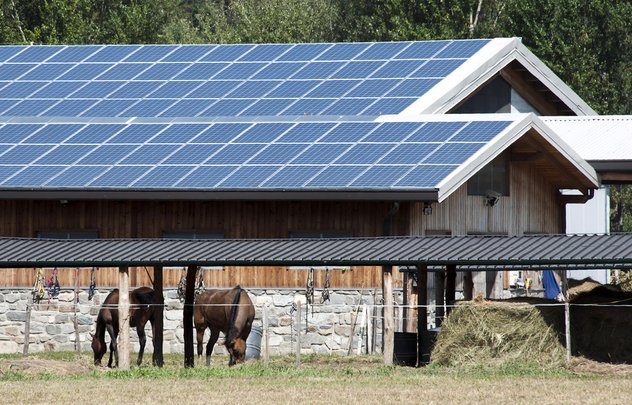
Agricultural enterprises
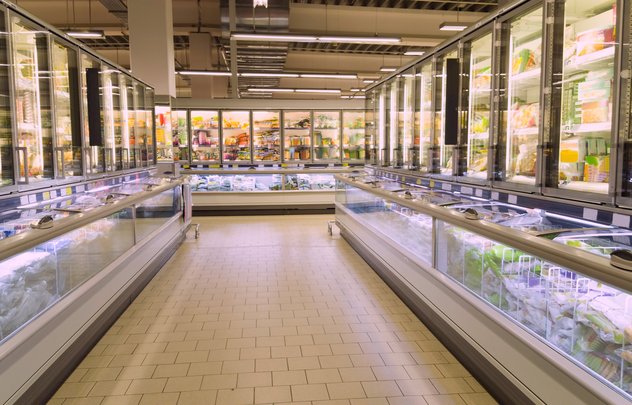
Supermarkets

Commercial businesses
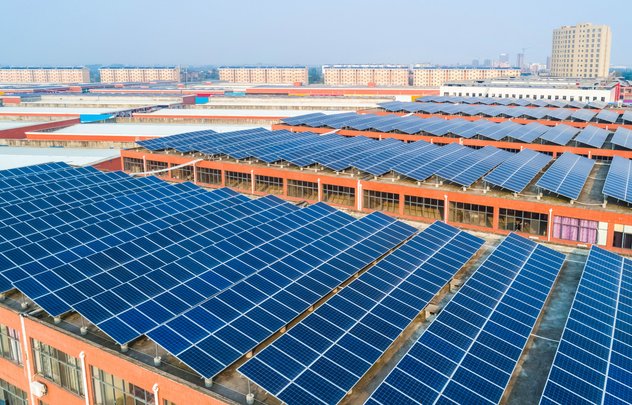
Quarters & Areas
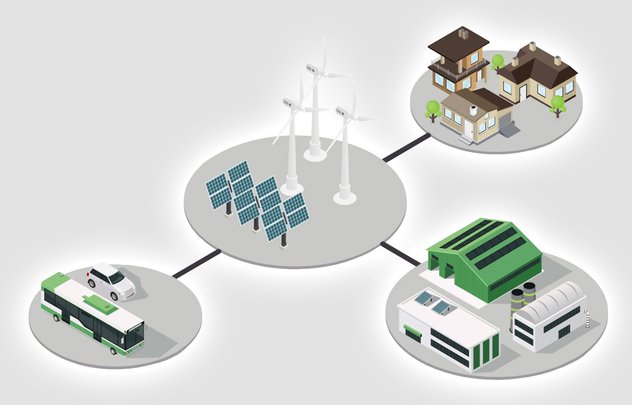
Sector couplings
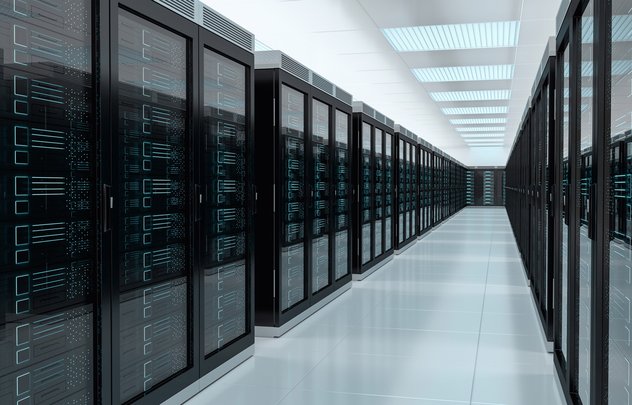
Data Centre & Emergency Power
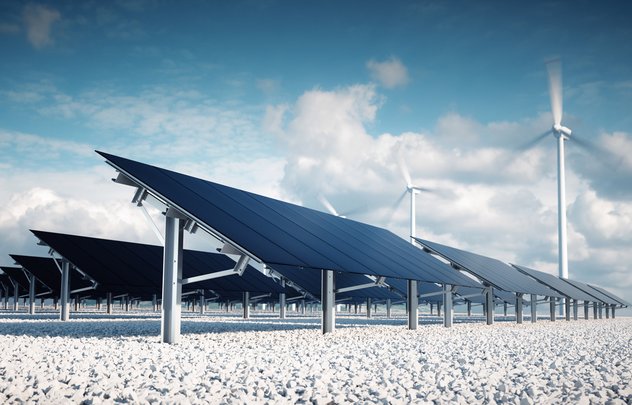
Capacity Firming
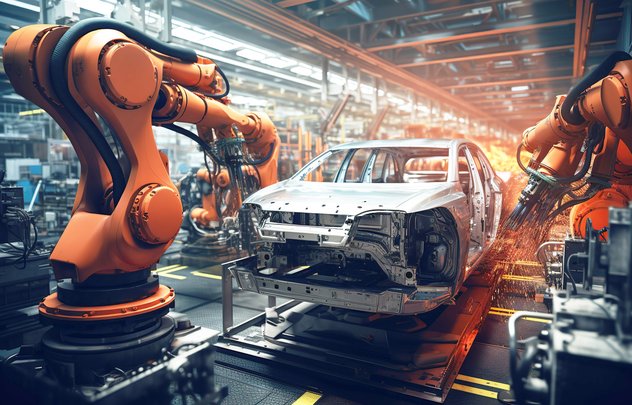
Industry
DC-ZEV with DConnect®
Imagine your neighbour has a large roof facing south and a photovoltaic system that produces much more than he can consume. A shared battery storage system buffers the surplus and both can profit from it. Maybe the next neighbour also has a solar system and other neighbours have none. Of course, the e-vehicle does not want to be powered by expensive grid electricity, but by its own solar power. With a small DC microgrid, everything can be connected and you simply form a new energy community (ZEV) and become your own master of your electricity. Provided, of course, you like your neighbour and the previous joint barbecues have worked out well.
You are the owner of a multi-family building with a lot of roof space for a photovoltaic system and you not only produce electricity, but also sell it to your tenants. One street away is the supermarket for the whole area. You join forces with it. The surrounding houses and commercial areas are still little used for PV. Here, too, a shared salt battery storage system makes the energy available to everyone at the right time - energy-efficiently via a small DC grid. Not only do you benefit from selling your electricity, but the tenants also benefit from cheaper electricity costs and independence from power outages.
Become an electricity provider for tenants/neighbours with DC-ZEV:
- If there are several roofs in an area, cover the most cost-effective roofs with PV
- Feed the PV electricity via a DC link to the various consumers and convert it locally into demand-based AC electricity
- Storage-sharing through a central salt battery storage for DC ZEV (cheaper CHF/kWh)
- DConnect® is a privately owned grid (not subject to an AC grid monopoly); the AC grid connections of the various buildings remain in place
- Higher failure safety due to decentralised islanded DC microgrid
More autonomy and self-sufficiency as well as independence from the power station:
- Own tariff models such as a flat rate (not allowed with AC grids) become feasible because DC grids are not subject to any regulator
- No grid operator or electricity company as intermediary, the higher returns can be collected or passed on to the tenants.
- Savings on power station meter rents
- Remain your own boss and master! Exemption from "mandatory direct marketing" possible for large PV systems.
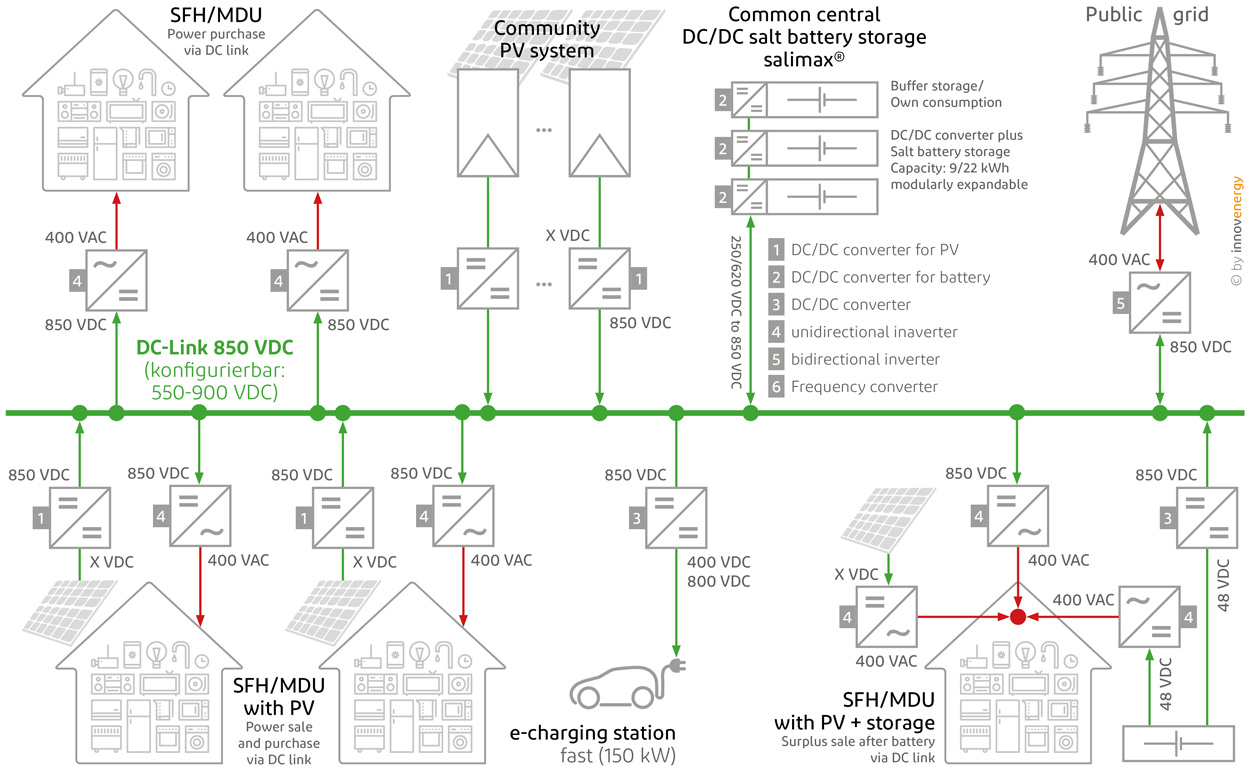
DC area grids with DConnect®
You are planning to install photovoltaics on several roof tops or on a large area of land. You expect to produce a lot of surplus energy. But you don't want to feed the electricity into the grid uneconomically after your own needs have been met. Perhaps the grid connection capacity is not sufficient and a grid expansion would be necessary. That is one of the reasons why you are considering a larger storage solution. The area is still young and will grow steadily over the next few years. The requirements for the energy transition are getting increasingly strict. What if an efficient DC grid could grow bit by bit with its producers and consumers?
Smaller areas like the supermarket next door could connect to the commercial enterprise around the corner. Barns and stables of the nearby farm offer enough space for large photovoltaic systems. The entire neighbourhood can benefit from this via a DC link. Modern residential neighbourhoods will be strongly oriented towards energy efficiency in the years to come. There are many reasons and many possibilities for a DConnect® microgrid.
- Higher energy efficiency within an area through DC grid
- Integration of different buildings, areas and sectors into an independent DC grid
- Better use of the (partly distributed) site areas, e.g. through larger or several PV systems
- Expansion of your own area through a ZEV: Integration of commercial use of neighbouring businesses into your own residential area OR integration of private use of neighbouring residential buildings into your own commercial area
- High autonomy and self-sufficiency through island capability
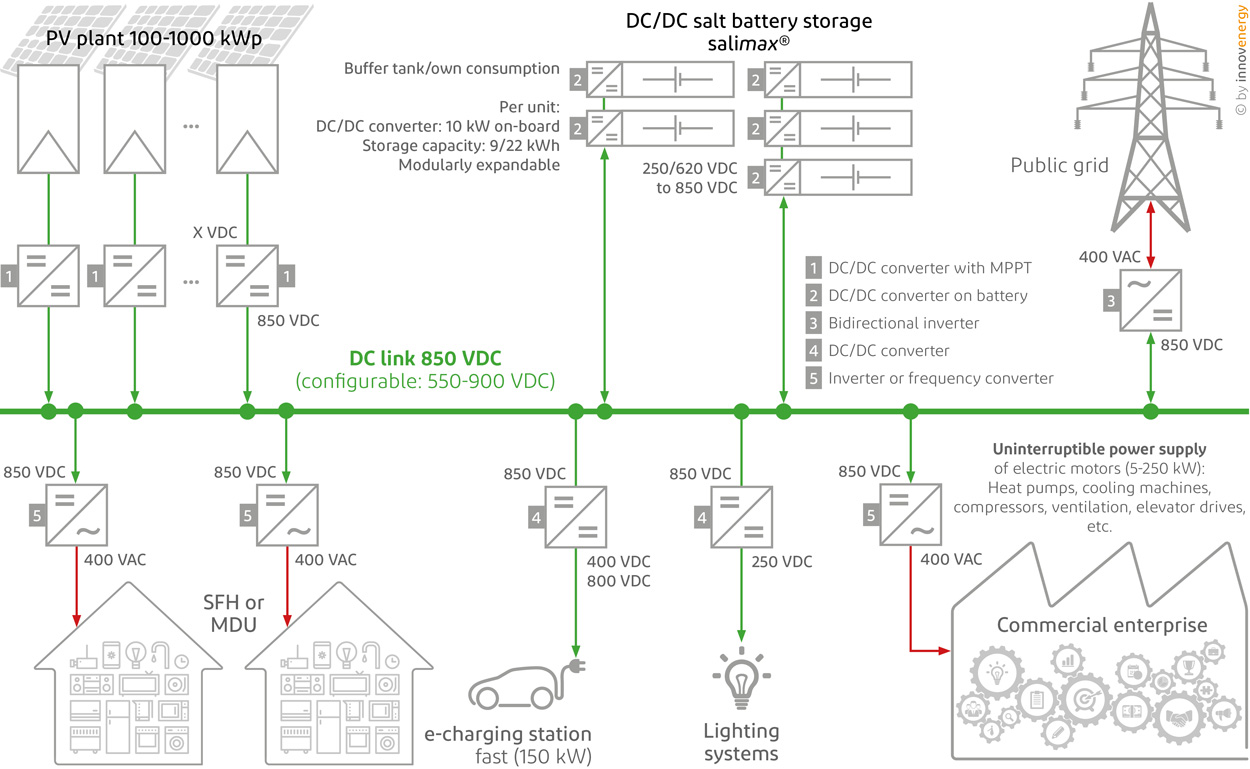
Sector coupling with DConnect®
Traditional sectors are electricity, heating or cooling, transport and industry. Most of the time, these have been considered as being independent of each other. Sector coupling is the cross-linking of these traditional or new sectors within the energy sector as well as industry. The idea behind this concept is to leave behind approaches to solutions that are only tailored to individual sectors and to move towards a holistic view of all sectors that enables a better and cheaper overall system. Intelligent sector linking can bring about a significant reduction in energy consumption with the help of energy-efficient technologies such as heat pumps or e-vehicles. In addition, sector coupling manages to balance out the fluctuations of renewable energies such as wind energy and solar energy. At the same time, sector coupling increases energy security. Precisely because sector coupling enables synergy effects in the integration of high shares of renewable energies, it is seen as a key concept in the energy transition and the development of energy systems with 100% renewable energies. There is a broad consensus that sector coupling is necessary to implement the energy transition and meet climate protection targets.
Examples of different sector couplings:
Electricity sector
DC-coupled stationary salt battery storage systems
DC-coupled (bidirectional) electric vehicles
HVAC sector
Heating and cooling machines, ventilation systems via frequency inverters from DC-Link onwards
Mobility sector
DC/DC charging stations for electric vehicles from DC-Link onwards
Power-to-gas sector
DC/DC converters for electrolysers and fuel cells
Other sectors
Other sectors can also be generated according to demand
DC emergency power supply with DConnect®
The thought of a power outage during an operation is probably a horror scenario of the past. A murmur of horror would spread across the population if there were a power failure in the telecommunications control centres or the server landscapes of our internet - our entire economy would be paralysed for a moment. We would be less directly affected by a power failure in cold stores or heat-sensitive animal farms. But for those affected, it would be a disaster. That is why there are UPS systems, i.e. uninterruptible emergency power supplies, which switch on immediately in the event of a power failure and keep everything running as if nothing had happened. Such systems are expensive. Expensive because they only exist for emergencies and are regularly maintained in the hope that they will never be needed. The combination of photovoltaic system and storage can kill two birds with one stone in a DC grid suitable for islands: self-consumption AND emergency power. Part of the storage is reserved for emergencies, the other part for self-consumption. This way, the emergency power system, or the part that has been reserved as such, can be amortised.
Power AND emergency power supply for ...
- Data centres and control centres
- Hospitals and nursing homes
- Cold stores and warehouses
- Biogas plants and pumping stations
- Poultry and animal farms
- Lighting systems and elevators
- Alarm and locking systems
- and much more.
UPS systems can be combined with PV systems and storage:
- Part of the storage is reserved for grid failure (UPS)
- Another part for self-demand optimisation
- USV is amortised through self-demand optimisation
- UPS with shallow cycles have an extremely long service life (20 years)
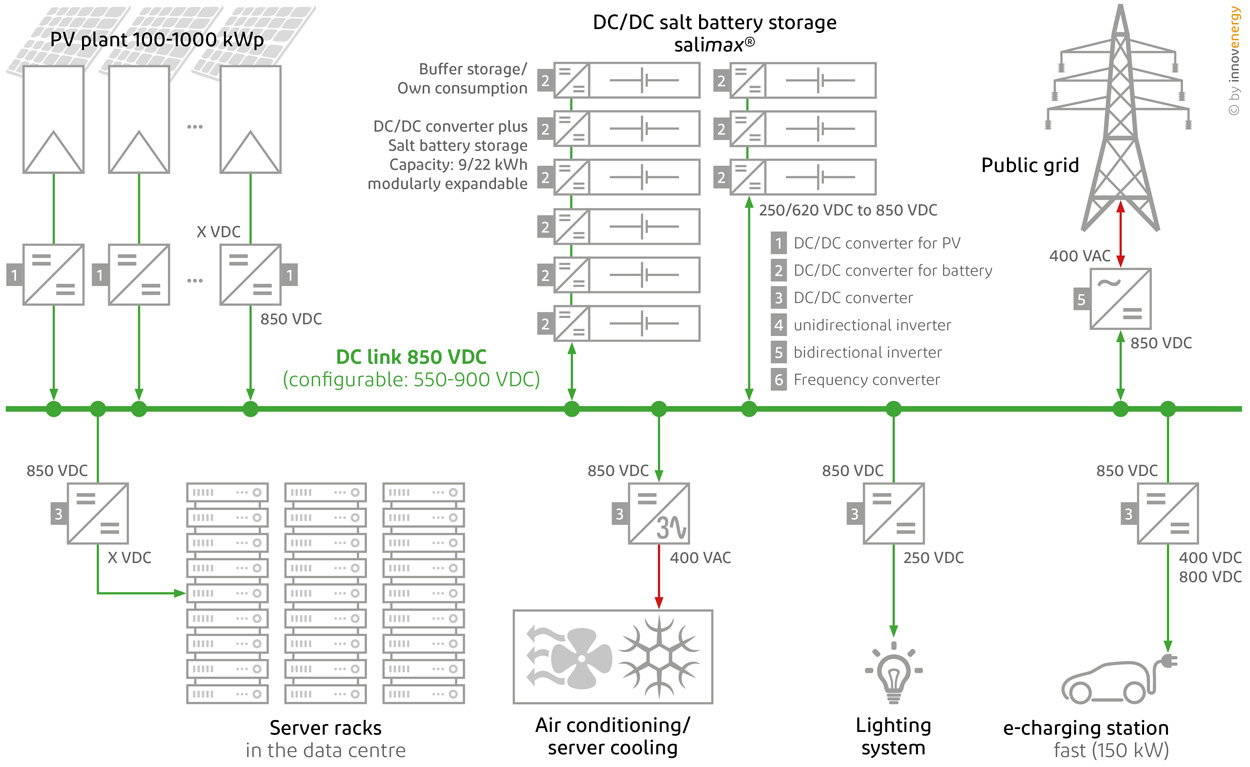
Supermarkets and commercial enterprises with DConnect®
Large roof surfaces on the supermarket or a commercial hall provide sufficient electricity from the photovoltaic system. And the entire PV potential can be exploited without permit or grid connection problems. This is because the internal consumers within a DC Link regulate themselves. Night-time consumption requires correspondingly large battery storage, because cooling and heating systems or machines on the night shift want to be supplied even when it is dark.
Part of the battery capacity is reserved for the emergency "power failure". An additional emergency generator can be integrated and ensures that even in the event of a prolonged power failure, nothing in the cooling chambers will thaw and operations can continue as normal. Depending on the application, terminal devices can be operated via DC/DC converters, inverters or frequency converters on the DC link.
- Sensible sector coupling possible
- Emergency power supply via DC link
- Additional emergency generator can be integrated
- DC link freely configurable to operational requirements (550-900 VDC)
- Emergency power supply of sensitive equipment such as servers, cooling chambers, etc.
- Avoidance of AC grid expansion with high PV potential
- Full PV utilisation possible
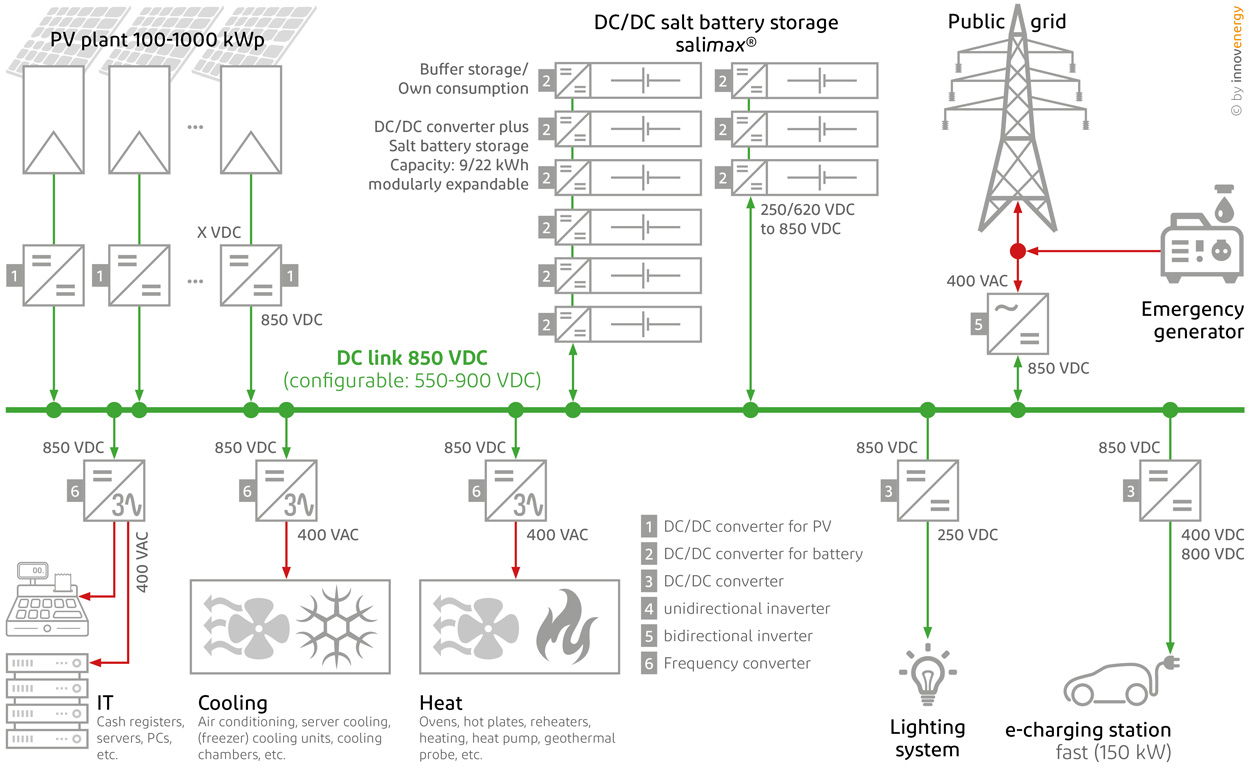
Agricultural enterprises with DConnect®
Greenhouses need a lot of light, heat and humidity. The laying battery needs heat and chicken farming urgently needs ventilation. Piglet rearing needs infrared lamps, fish farming needs tanks at the same temperature all the time. The dairy farmer depends on the milking machine and milk cooling. The cheese dairy needs the same constant temperature and humidity for months. The dependence on the public electricity grid is not only existential, but also expensive. Yet almost all such farms could be self-sufficient with their large roof areas and a corresponding photovoltaic system. Or at least reduce their electricity bill enormously. An energy-efficient DC microgrid with ecological salt battery storage as well as a fully utilisable PV system are a possibility to cushion power peaks at low cost. Full autonomy as well as higher self-sufficiency are only the side effects for self-consumption optimisation, power security and electricity cost reduction. The existing diesel generator becomes a relic of the past without polluting the air every day - to the benefit of our environment. It is the backup for really long-term emergencies.
Areas of application
- Breeding farms
- Chicken farms and laying batteries
- Pig and piglet breeding
- Fish farms
- Zoological gardens, terrariums, aquariums, pet shops
- Garden centres and plant nurseries
- Dairy farms and cheese dairies
- Slaughterhouses and large butcheries
- among others
Applications
- Drying plants
- Irrigation and humidification systems
- Ventilation systems
- Cleaning systems
- Lighting systems
- Cooling systems
- Heating and warming systems
- and much more
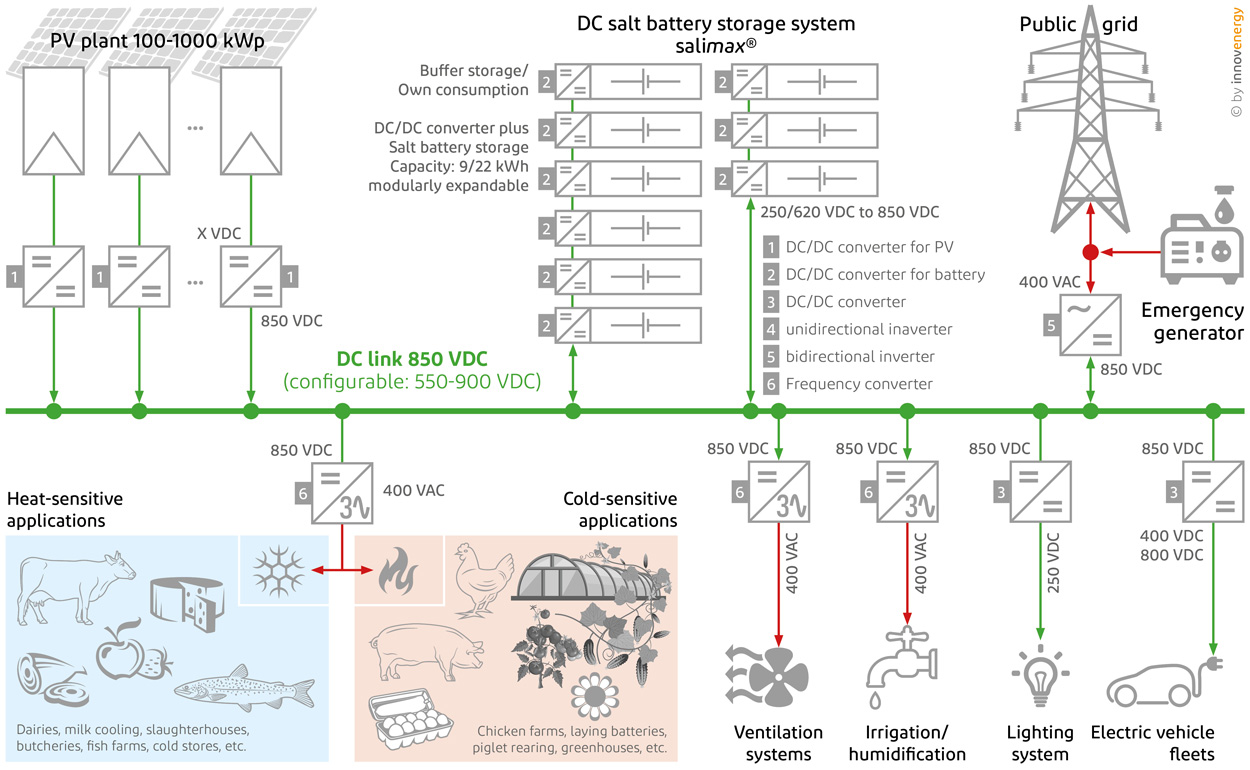
Capacity firming with DConnect®
A nightmare for energy suppliers: how to reconcile consumer consumption and the production of unreliable renewables?
We constantly need energy, and we need it in varying amounts at different times. Renewable energy is just as irregular, but unfortunately often at different times than energy is consumed. The solution is large buffer storage units to store surpluses and then release them again when loads are high. With a clean storage solution with DConnect® and salimax®, the energy provider can sit back and relax.
- Turning irregular renewable energy into predictable energy production (necessary for the replacement of fossil energy sources).
- Balancing production power peaks and consumption power peaks (grid-friendly peak shaving)
- More balanced AC grid feed-in from PV systems
- Control of the use of the AC grid inverter by the utility company is possible: e.g. for drawing energy from the storage units during AC peak loads in the evening ("duck curve": high AC consumption but little PV production)
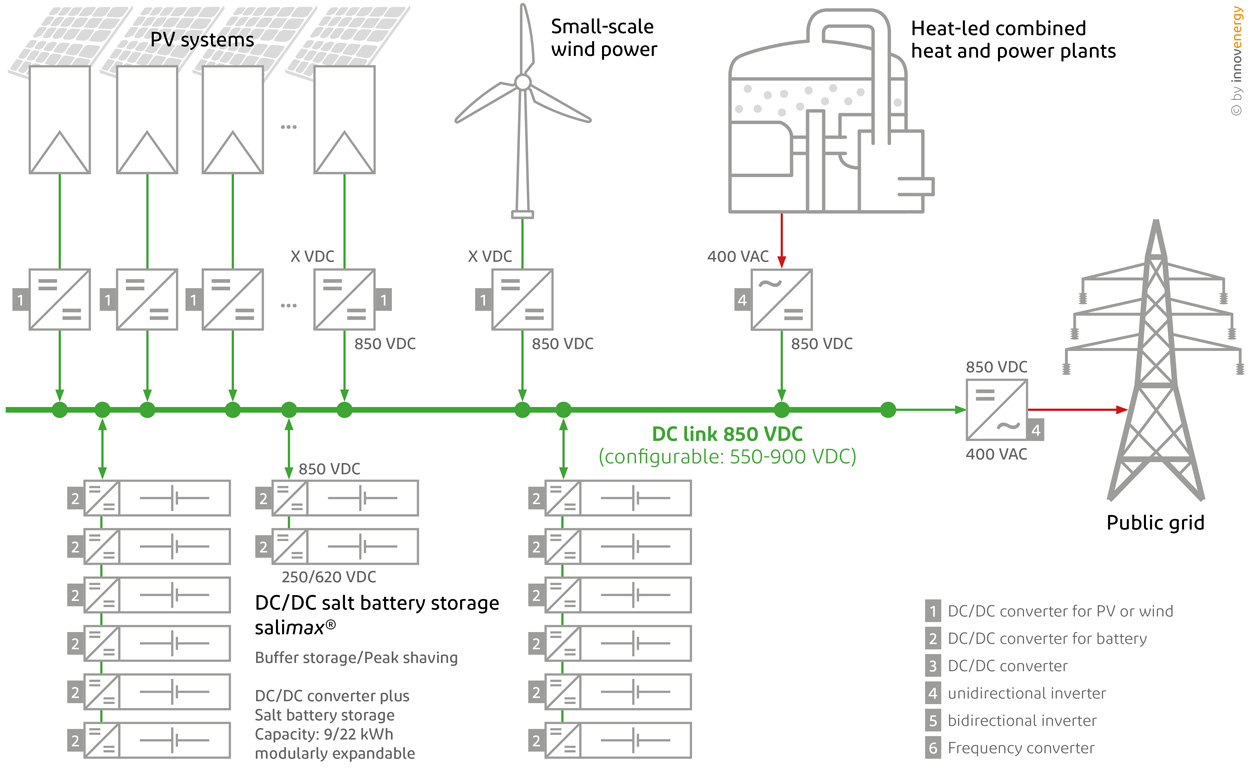
DConnect® in industry
The motto is: "Solar energy from the roof directly into the machine!"
- Integrate your photovoltaic energy directly into production processes
- Avoid interventions of the grid operator in your electricity production
- Ensure uninterrupted operation in the event of grid failures
- Use 40-50% less copper for your electricity infrastructure
- Avoid conversion losses and save up to 10 % energy
- Save on expensive mains filters
- Reduce power peaks to the grid
- Optimise your own consumption via battery storage
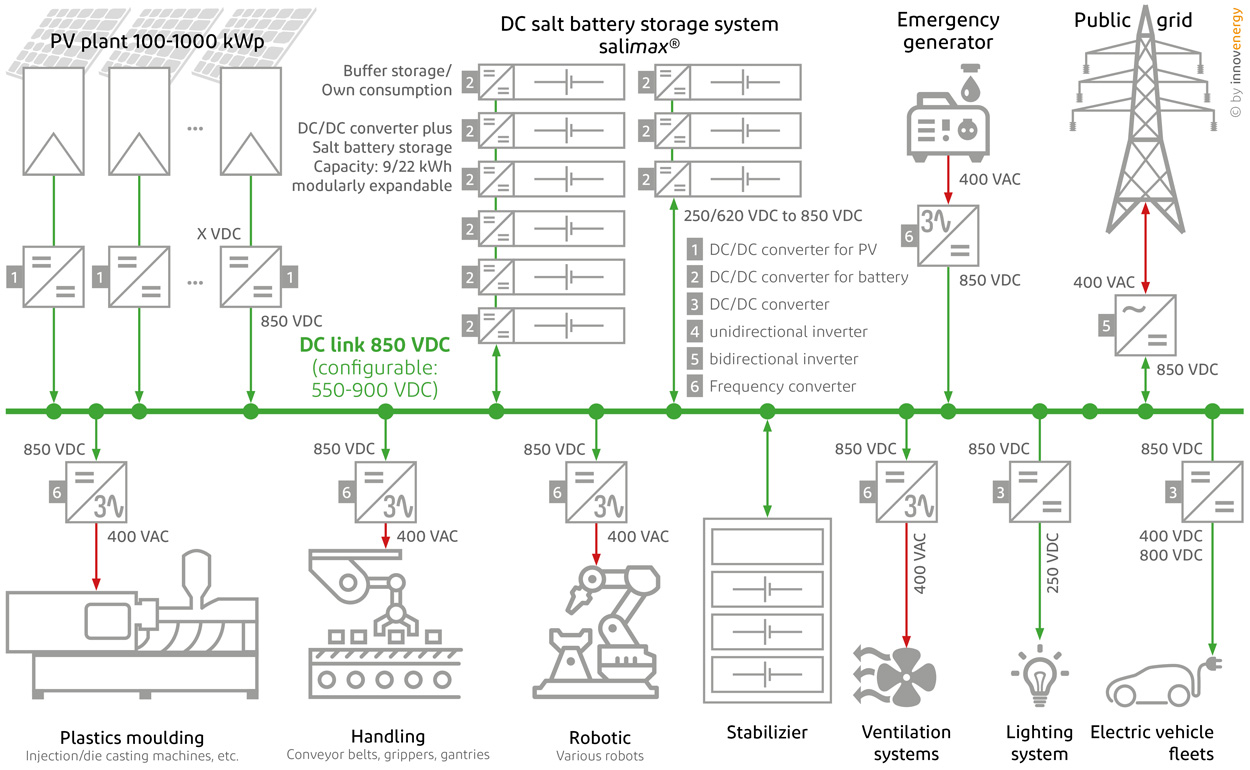
You want to know what the whole thing costs now?
To do so, click on the "Start enquiry" button on the left and describe your project in a few words. An expert will contact you within the next few days.
